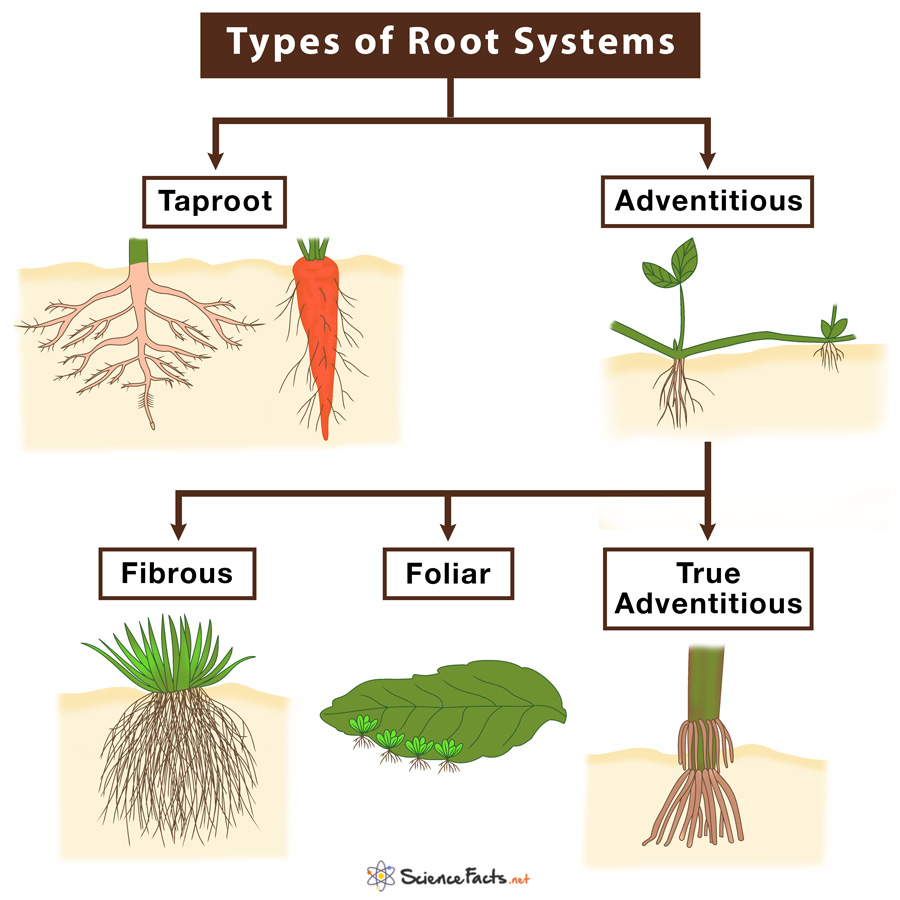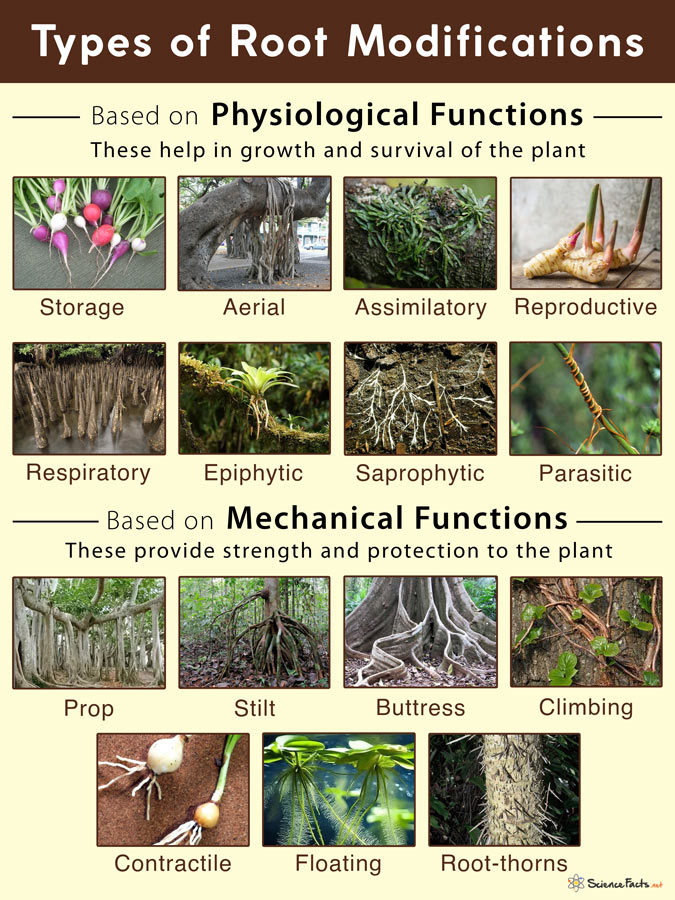Types of Roots
Roots are the underground part of the plant body that is usually colorless. It is primarily responsible for anchoring the plant to the soil, absorption of water and minerals, and storage of reserve foods. Although all plant roots perform similar functions, some differ significantly in their structure and adaptations to carry out some other specialized functions. Root, along with all its associated parts, constitutes the root system.
Types of Root System Based on Structure
Based on their structure, all plant root systemsare broadly classified into two main types:
1. Taproot or Primary Root System
It is the root system that develops from the growing embryo (radicle) of a germinating seed. The taproot is the true root that grows vertically downwards and produces many lateral roots called root hairs. The taproot system is present in all dicot plants.
Examples: Mango, carrot, radish, sugar beet, and parsnip
2. Adventitious Root System
It is the root system that develops from any part of the plant other than the radicle – usually a stem and sometimes a leaf. The adventitious roots are found in monocot plants where the taproot is short-lived.
Examples: Grass, sugarcane, oak, and ivy.
Based on the origin of the adventitious root, they are further classified into:
a) Fibrous Roots
They are slender, branched, bushy roots that grow directly from the stem of the plant. Fibrous roots are formed from moderate branching of the taproot and do not penetrate deep into the soil.
Examples: Grass, rice, wheat, maize, and banana.
b) Foliar Roots
They arise naturally from leaf veins or petioles due to some injury on the leaf. The injured region develops new buds called foliar buds, which later give rise to these roots for new plants to grow. Sometimes, artificial application of plant growth hormones can also stimulate the plant to develop new foliar buds from the region where it is applied.
Examples: Pogostemon, rubber plant, Bryophyllum, and Begonia.
c) True Adventitious Roots
Lateral buds that arise from parts of the stem (at the nodes and internodes) are called true adventitious roots.
Examples: Aerial roots of a banyan tree, stilt roots of sugarcane, and clasping roots of the money plant.
Although all plant roots are mainly classified into two main types based on their structure, some roots undergo further modifications to carry out other dedicated functions, based on which they are classified below.
Types of Root Modifications
Roots of some plants undergo a change in their shape and structure to perform specialized functions, other than the basic ones. The different types of those modifications are listed below:
Based on Physiological Functions
Sometimes roots are modified to perform the basic chemical and physical processes needed by the plant to grow and survive, based on which roots are classified into the following types:
1) Storage roots: They become fleshy to store reserve food materials. Examples: Radish, carrot, beet, Mirabilis, and Echinocystis
2) Aerial roots: Also called epiphytic roots, they are found above the ground and helps plants to absorb moisture from the air. Examples: Mangroves, banyan trees, common ivy, and poison ivy.
3) Assimilatory roots: Also called photosynthetic roots, they are green roots which prepare food for the plants by photosynthesis. Examples: Taeniophyllum,Trapa, and Tinospora.
4) Reproductive roots: Some fleshy adventitious roots develop buds that can grow into a new plant. Examples: Sweet potato and dahlia.
5) Respiratory roots: Also called pneumatophores or breathing roots, they are found above the ground and helps plants in gas exchange. Examples: Mangrove plant, Heritiera, Sonneratia, Avicennia, and Ceriops.
6) Epiphytic roots: Also called hygroscopic roots, they grow on the trunk and branches of trees and help to absorb moisture using special sponge-like tissue called velamen. They act as the main root systems of epiphytic plants. Examples: Venda and Dendrobium.
7) Saprophytic roots: Also called mycorrhizal roots, they are associated with fungal hyphae for the absorption of water and minerals. Examples: Monotropa and Sarcodes.
8) Parasitic roots: Also called haustorial roots, they grow on other plants and depend partially or totally on the host to derive nutrients for their own survival. Examples: Cuscuta and Viscum
Based on Mechanical Functions
Some roots get modified to provide strength and protection to the plant, based on which roots are classified into the following types:
1) Prop roots: These are adventitious roots that arise from the aerial branches of trees and help in their additional support. Examples: Banyan tree, rubber plant, and corn
2) Stilt roots: They are obliquely growing adventitious roots that develop from the lower nodes of the stem to give additional support to the plant. Examples: Sugarcane, maize, sorghum, Pandanus, and Rhizophora.
3) Buttress roots: The horizontal plank-like aerial, adventitious roots that develop at the base of the stem to give additional support to the plant. Examples: Terminalia and Salmalia.
4) Climbing roots: The adventitious aerial roots that arise from the nodes or internodes of weak stemmed plants that need support to climb. Examples: Pothos, Piper betel, Vanilla, and Hedera.
5) Contractile roots: Also called pull roots, they are modified, underground stem that adjusts itself to contract or swell according to the depth of the soil for the absorption of water and minerals. Examples: Canna, Crocus, Allium, Lilium, and Freesia.
6) Floating roots: They develop from the nodes of floating plants that help the plant to float in water. Examples: Water lily and duckweed.
7) Root-thorns: The adventitious roots sometimes become hard and pointed to help reduce water absorption in the plant to adapt to the environment with low water content, as found in the arid and semiarid regions. Examples: Pothos, Acanthorhiza, and Iriartea.
Although roots are one of the fundamental structures in a plant that carries out a variety of functions either naturally or through modifications, some group of plants called bryophytes (e.g., mosses and liverworts) does not have roots. They require direct contact with water to absorb water and minerals through their leaves.
-
References
Article was last reviewed on Friday, February 3, 2023






informative
well explained!
well explained in simple terms. great blog
Attractive part of content. I’d like to find out more? I’d care to find out more details.I have read so many content on the topic of the blogger lovers however this paragraph is truly a good post, keep it up..
I wish to receive down loads of school materials .